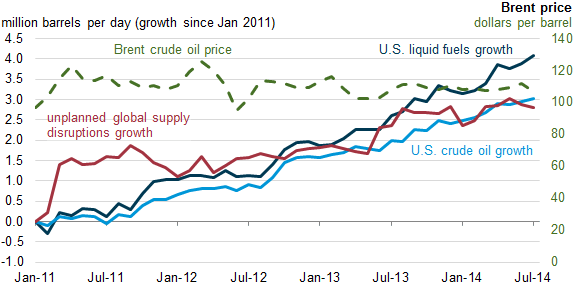EIA Report: U.S. Liquid Fuels Growth Counterbalances Global Supply Disruptions
According to EIA, U.S. liquid fuels production growth has significantly contributed to counterbalancing unplanned global supply disruptions and decreasing crude oil price volatility since 2011.
On August 27, 2014, the Energy Information Administration (EIA) released a report highlighting the significant role of U.S. liquid fuels production growth in counterbalancing global supply disruptions in recent years, though the substitution is not exactly one-for-one due to differences in quality and location.
Notably, record-setting U.S. liquid fuels production growth of more than 4.0 million barrels per day (bbl/d) from January 2011- July 2014 more than offset unplanned global supply disruptions, which grew by 2.8 million bbl/d over the same period. Liquid fuels include crude oil, hydrocarbon gas liquids, biofuels, and refinery processing gain, with crude oil representing 3.0 million bbl/d of production growth. Global unplanned supply disruptions peaked at 3.5 million bbl/d in May. International Energy Agency data show that current supply disruption level is the highest since the 1990-1991 Iraq-Kuwait War, when supply disruption reached 4.3 million bbl/d.
Growth in U.S. Liquid Fuels Production and Unplanned Global Supply Disruptions, Jan 2011-July2014 (EIA)
According to EIA, U.S. production growth has also contributed to a decrease in crude oil price volatility since 2011. Monthly average Brent price over the 13-month period from June 2013-June 2014 remained in the price range of $107-$112 per barrel, fluctuating within a $5/barrel range. By comparison, in the previous 13-month period (June 2012-June 2013), Brent price fluctuation range was $21/barrel.
The EIA’s December 2013 Petroleum Supply Monthly reported that total U.S. crude oil production in 2013 averaged 7.5 million bbl/d, the highest since 1989. It also noted a 15 percent increase in U.S. production from 2012-2013, the largest annual percentage increase since 1940. Domestic production growth supported high refinery utilization rates, reduced crude oil imports, and changed domestic and global crude oil and petroleum trade flows.
Tags:
Replies to This Discussion
-
Permalink Reply by 0ym9x5ag7ury2 on September 2, 2014 at 2:21pm
-
Eric,
Great News, but, the Buck Well 6H in Carroll County won't be helping with the US Liquids growth due to having "Bad NGLs".
Bruce Buck told me himself that he hasn't seen a dime from NGLs yet due to the fact they have been bad according to Chesapeake Energy.
I can't wait for everyone to have the experience of a lifetime when you get your first royalty check.
How can an O&G Company steal from a landowner? Let me count the ways. I'll get back to you when the results are in.
Top Content
Latest Activity
© 2025 Created by Keith Mauck (Site Publisher).
Powered by
![]()
| h2 | h2 | h2 |
|---|---|---|
AboutWhat makes this site so great? Well, I think it's the fact that, quite frankly, we all have a lot at stake in this thing they call shale. But beyond that, this site is made up of individuals who have worked hard for that little yard we call home. Or, that farm on which blood, sweat and tears have fallen. [ Read More ] |
Links |
Copyright © 2017 GoMarcellusShale.com

